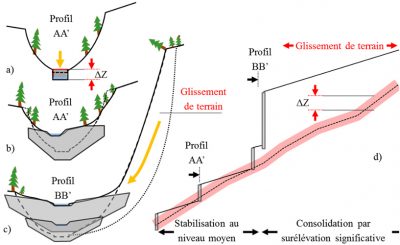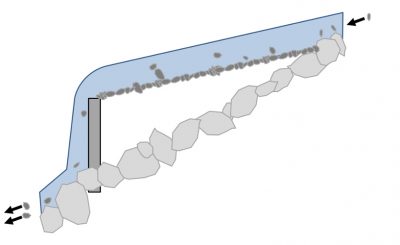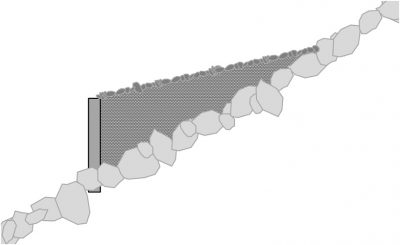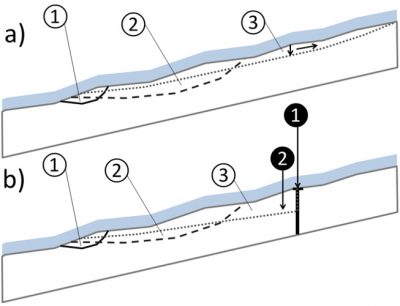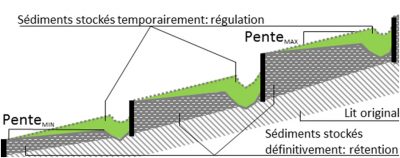1. Stabilization of torrent beds
Figure 1. Bed stabilization: Diagram of a profile across torrents showing the effect of longitudinal profile erosions and the origin of certain respirations of the bed: a) erosion of the bed leading to a lowering of its level, this erosion leads to b) lateral instabilities; these two processes being stabilized by c) the installation of an adapted dam: built above the original bed, preventing bank erosion and destabilization and moving the bed axis to the bank least susceptible to erosion. [Source: © G. Piton] Stabilizing torrent beds is the most common function of torrential correction dams. It aims to prevent longitudinal and/or lateral erosions. The spontaneous or artificial recovery of vegetation is a direct effect of the stabilization of the bed by dams. The coupling mechanism between bed stabilization and bank vegetation recovery could be summarized as follows: incisions in stream beds (Figure 1a) regularly lead to bank slippages (Figure 1b), preventing the vegetation from becoming permanently fixed. After the dams have landed, the marked incisions can no longer take place, stabilizing the bank feet and reducing their slope; these more stable slopes are then more suitable for vegetation installation (Figure 1c).
2. Slope consolidation
Figure 2. Slope consolidation: profiles across the bed of a stream. Reminders of the existence of (a) erosion / vertical deposition leading to a regular variation in the bed level (ΔZ); (b) the role of stabilization dams fixing the mean bed level substantially in its variation zone, (c) in contrast to consolidation dams which are located near landslides where they significantly raise the level of the stream bed (elevation >> ΔZ). In (d), the length profile illustrates the difference between the stabilized AA’ profile and the consolidated BB’ profile. [Source: © G. Piton] slope consolidation dams is to combat and reverse this trend: significantly raising the bed level (Figures 2c and d) through a dam or series of dams aims to consolidate the foot of the slope and slow down the activity of the stream.
Bed stabilization has an equivalent effect on the banks (Figures 2a and b), but it maintains the corrected level substantially at the mean level of the bed (this level is not constant but naturally varies by deposit-erosion cycles, called “torrential breathing”).
3. Slope reduction
Figure 3. Slope reduction: diagram of a deposit upstream of a dam: the latter is made of finer materials, usually transported, which are more mobile and therefore settle on a less steep slope than the large blocks of the paving. [Source: © G. Piton] reduction in the slope . The equilibrium slope becomes less than the initial slope. This phenomenon is relevant to torrential correction since lower slopes generate less energetic flows, thus reducing many problems related to torrential floods (transport volume and grain size, erosions, etc.).
4. Sediment retention
Figure 4. Sediment retention: sediment deposition in the upstream section of a dam resulting in the permanent storage of a given volume of sediment (dark grey). [Source: © G. Piton] sediment retention is present but generally secondary on all structures (the stored volume is very small compared to the volume transported by the stream over the life of the structure). However, there are a few structures, called retention dams , built specifically to trap a maximum volume of sediment in their landing area.
Once the structure was fully landed, new dams could eventually be built near the main structure to extend the filling of the upper valley. The development of earth-moving machinery has made it possible to clean the structures after each flood, making the implementation of new large retention structures quite rare.
5. Regulation of solid transport
Figure 5. Regulation of solid transport: longitudinal profiles illustrating the difference in the propagation of vertical bed erosions. Steps from ① to ③. In the case of (a) without a dam, the erosion event can spread far upstream, smoothing the profile. In the case (b) with a dam, the erosion episode cannot spread in the upstream section because the upstream level is fixed by the crest of the dam (hard point ❶). However, the erosion of the downstream section can develop at greater depth against the dam (at ❷) since the upstream bed is no longer destabilized and therefore does not provide materials to fill the eroded area as in case (a). N.B. Only eroded volumes are represented, not volumes deposited in a spirit of simplicity. [Source: © G. Piton] prevents the propagation of regressive erosions and depavages (Figure 5).
The sections located between dams thus become semi-independent compartments (they always receive upstream flows but changes in bed level no longer influence the upstream compartment).
Figure 6. Regulation of solid transport: long profiles illustrating the temporary retention areas (in green) between the minimum and maximum slopes of deposition that vary over time. This phenomenon completes sediment retention. [Source: © G. Piton] thus regulating episodes of high transport . This trend has led some practitioners to consider that dams are particularly useful for torrential correction because they deliver “retail”, what the torrent delivered too brutally “in bulk” .

